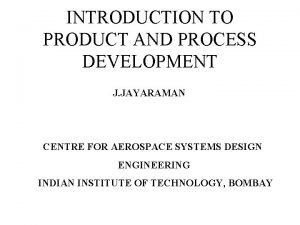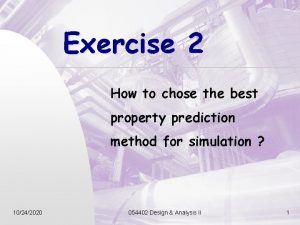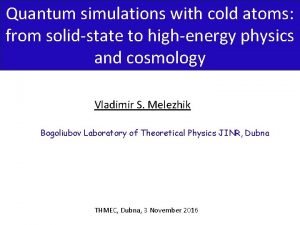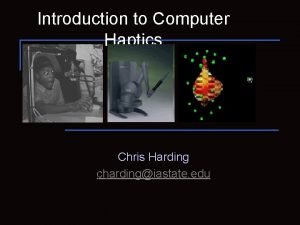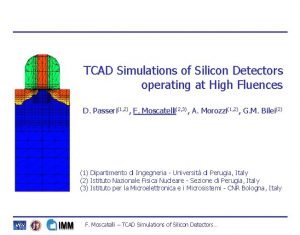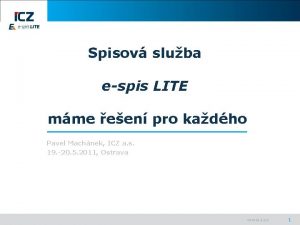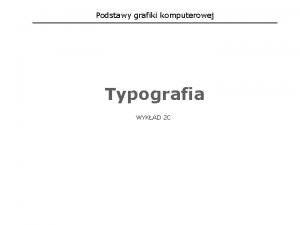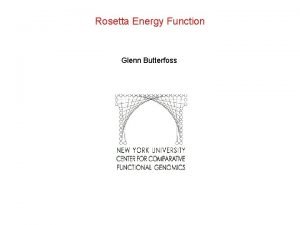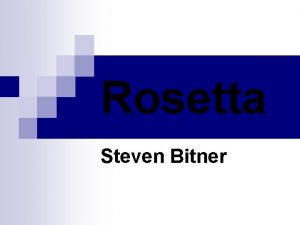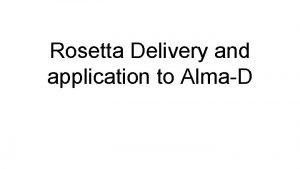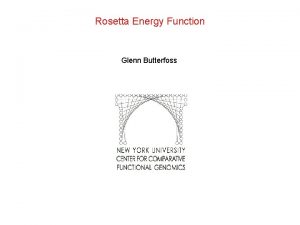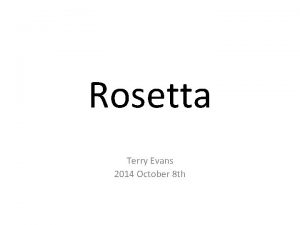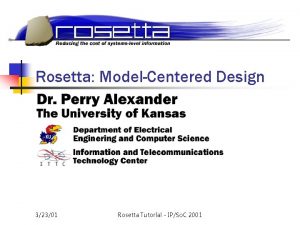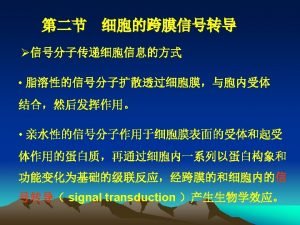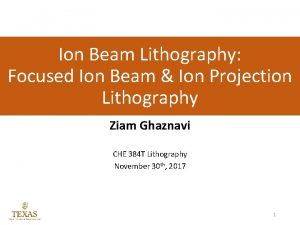ROSETTA simulations on SPIS for DFMS ion measurements





















- Slides: 21

ROSETTA simulations on SPIS for DFMS ion measurements G. Tcherniatinsky, J. J. Berthelier LATMOS

Context : ROSETTA mission and ROSINA mass spectrometer Up to September in 2016, ROSETTA was an orbiter analyzing the coma of comet 67 P. ROSINA DFMS: instrument facing comet core and using magnetic mass spectrometer to separate masses with a resolution 1/3000 on neutrals.

What does ROSINA DFMS really measures in ion mode ? 67 P coma : density ~ 1000 part/cm³, electron temp ~ 7 e. V → Spacecraft charging ~ -40/0 V Ion mode : ions entering ROSINA DFMS have already been deflected by plasma sheath. DFMS is looking straight in a « mirage » : we need to know how the field of view is deflected in ion mode before using its data.

Contents of the study ROSETTA step-by-step modelization of the sheath using SPIS and study of the influence of each parameter (last presentation in 2017) Presentation of the results of ROSETTA model. Study of a sphere and a panel in the same plasma conditions : SPIS in a low ion temperature (0. 025 e. V). SPIS issues and questions.

Geometrical model ROSETTA NUMERICAL MODEL (1) NUMERICAL MODEL (2) 12 m Y 9 m B 2 Z 3 m 2 m X Y 2 m B 1 16 m 2. 8 m 2 m X Z B R 5 m

Geometrical model ROSETTA NUMERICAL MODEL (3) 2 m 4 m X B 2 B 1 2. 3 m 12 m m 0. 7 Y 4 m Z

ROSETTA simulation description Reducted size of solar panels (15 m to 3 m). Effect studied on SPIS in last presentation: potential less negative of ~2 V. Verification with PIC models : equilibrium value of potential is almost the same. Variation of parameters velocity, temperatures, densities, presence of photoelectrons.

Electron model Maxwell-Bolzmann Density (part/m³) 10⁹ Electron temp (e. V) 7 Ion temp (e. V) 0. 0258 Velocity x axis (m/s) 600 Solar power x axis (relative to 1 UA power) 0. 0 Mesh size (m) 0. 6 Detector mesh size 0. 02 Duration (s) 0. 02 Simulation. Dt (s) 1. 0 e-4 Plasma. Dt (s) 1. 0 e-4 Potential bias (V) -20 Debye length (m) 0. 61 Equilibrium potential (V) -26 Ion log density map normal Z Potential map normal Z

Electron model Maxwell-Bolzmann Density (part/m³) 10⁹ Electron temp (e. V) 7 Ion temp (e. V) 0. 0258 Velocity x axis (m/s) 600 Solar power x axis (relative to 1 UA power) 0. 6 Mesh size (m) 0. 6 Detector mesh size 0. 02 Duration (s) 1. 4 e-4 Simulation. Dt (s) 2. 2 e-7 Plasma. Dt (s) 2. 2 e-7 Potential bias (V) -20 Debye length (m) 0. 61 Equilibrium potential (V) -16 Ion log density map normal Z Potential map normal Z

Study of simpler geometries to check our results We observe that the ion current collected by spacecraft at equilibrium is larger than current entering external boundary. (55 u. A against 100 u. A) Very low ion temperature (0. 025 e. V) in comparison with electron temperature (7 e. V) The results seems reasonable on ROSETTA, but become unreasonable on simpler geometries. Why ?

Geometrical models sphere & panel

Electron model Maxwell-Bolzmann Density (part/m³) 10⁹ Electron temp (e. V) 7 Ion temp (e. V) 0. 0258 Velocity x axis (m/s) 0 Solar power x axis (relative to 1 UA power) 0. 0 Mesh size (m) 0. 6 Detector mesh size 0. 02 Duration (s) 0. 01 Simulation. Dt (s) 1. 0 e-4 Plasma. Dt (s) 1. 0 e-4 Debye length (m) 0. 61 X (m) 4. 3 Ion log density map normal Z Potential map normal Z

Electron model Maxwell-Bolzmann Density (part/m³) 10⁹ Electron temp (e. V) 7 Ion temp (e. V) 0. 0258 Velocity x axis (m/s) 600 Solar power x axis (relative to 1 UA power) 0. 0 Mesh size (m) 0. 6 Detector mesh size 0. 02 Duration (s) 0. 02 Simulation. Dt (s) 1. 0 e-4 Plasma. Dt (s) 1. 0 e-4 Debye length (m) 0. 61 X (m) 4. 3 Ion log density map normal Z Potential map normal Z

Electron model Maxwell-Bolzmann Density (part/m³) 10⁹ Electron temp (e. V) 7 Ion temp (e. V) 0. 0258 Velocity x axis (m/s) 0 Solar power x axis (relative to 1 UA power) 0. 0 Mesh size (m) 0. 6 Detector mesh size 0. 02 Duration (s) 0. 16 Simulation. Dt (s) 1. 0 e-4 Plasma. Dt (s) 1. 0 e-4 Debye length (m) 0. 61 X (m) 20. 3 Ion log density map normal Z Potential map normal Z

Electron model Maxwell-Bolzmann Density (part/m³) 10⁹ Electron temp (e. V) 7 Ion temp (e. V) 0. 0258 Velocity x axis (m/s) 600 Solar power x axis (relative to 1 UA power) 0. 0 Mesh size (m) 0. 6 Detector mesh size 0. 02 Duration (s) 0. 02 Simulation. Dt (s) 1. 0 e-4 Plasma. Dt (s) 1. 0 e-4 Debye length (m) 0. 61 X (m) 7. 3 Ion log density map normal Z Potential map normal Z

Electron model Maxwell-Bolzmann Density (part/m³) 10⁹ Electron temp (e. V) 7 Ion temp (e. V) 0. 0258 Velocity x axis (m/s) 0 Solar power x axis (relative to 1 UA power) 0. 0 Mesh size (m) 0. 6 Detector mesh size 0. 02 Duration (s) 0. 02 Simulation. Dt (s) 1. 0 e-4 Plasma. Dt (s) 1. 0 e-4 Debye length (m) 0. 61 X (m) 4. 3 Ion log density map normal Z Potential map normal Z

Electron model Maxwell-Bolzmann Density (part/m³) 10⁹ Electron temp (e. V) 7 Ion temp (e. V) 0. 0258 Velocity x axis (m/s) 600 Solar power x axis (relative to 1 UA power) 0. 0 Mesh size (m) 0. 6 Detector mesh size 0. 02 Duration (s) 0. 02 Simulation. Dt (s) 1. 0 e-4 Plasma. Dt (s) 1. 0 e-4 Debye length (m) 0. 61 X (m) 4. 3 Ion log density map normal Z Potential map normal Z

Electron model Maxwell-Bolzmann Density (part/m³) 10⁹ Electron temp (e. V) 7 Ion temp (e. V) 0. 0258 Velocity x axis (m/s) 0 Solar power x axis (relative to 1 UA power) 0. 0 Mesh size (m) 0. 6 Detector mesh size 0. 02 Duration (s) 0. 04 Simulation. Dt (s) 1. 0 e-4 Plasma. Dt (s) 1. 0 e-4 Debye length (m) 0. 61 X (m) 7. 3 Ion log density map normal Z Potential map normal Z

Electron model Maxwell-Bolzmann Density (part/m³) 10⁹ Electron temp (e. V) 7 Ion temp (e. V) 0. 0258 Velocity x axis (m/s) 600 Solar power x axis (relative to 1 UA power) 0. 0 Mesh size (m) 0. 6 Detector mesh size 0. 02 Duration (s) 0. 0168 Simulation. Dt (s) 1. 0 e-4 Plasma. Dt (s) 1. 0 e-4 Debye length (m) 0. 61 X (m) 7. 3 Ion log density map normal Z Potential map normal Z

Conclusions Velocity is not the only factor that permits the presence of an asymptote on the sheath for low ion temperatures. The plane shape does not allow us to get an asymptote for the potential near the external boundary. We observe a potential floor of ~-4 V when external surface is high enough. We observe an asymptote for ROSETTA sheath but not for simpler geometries : Why ?

Questions Very cold ions in SPIS : do you observe larger sheaths ? How do you solve this issue ? Possibility to restart a simulation from a registered intermediate state ? Huge difference of plasma. Dt when using Boltzmann models for electron population. Do you use very low plasma. Dt on Boltzmann ? Precise documentation of the model ? → How PIC particles are generated ? (On time steps ? On nodes? ) → How electron current is computed at each simulation. Dt when we use Boltzmann model ?
 Dipolo dipolo inducido
Dipolo dipolo inducido Fuerzas dipolo dipolo ejemplos
Fuerzas dipolo dipolo ejemplos Dispersion forces
Dispersion forces Ion dipolo
Ion dipolo Pinpoint simulations 777
Pinpoint simulations 777 Don't gamble with physical properties for simulations
Don't gamble with physical properties for simulations World history simulations
World history simulations Baton simulations
Baton simulations Clinical simulations in nursing education
Clinical simulations in nursing education Simulations for solid state physics
Simulations for solid state physics Chris harding simulations
Chris harding simulations Payroll card
Payroll card Tcad simulations
Tcad simulations Uporządkowany spis książek
Uporządkowany spis książek E spis lite
E spis lite Razlagalni spis primer
Razlagalni spis primer Spis form
Spis form Spis liter cyfr i innych znaków danego kroju pisma
Spis liter cyfr i innych znaków danego kroju pisma Kako napisati spis
Kako napisati spis Spis polyu
Spis polyu Frontalism
Frontalism Rosseta login
Rosseta login




